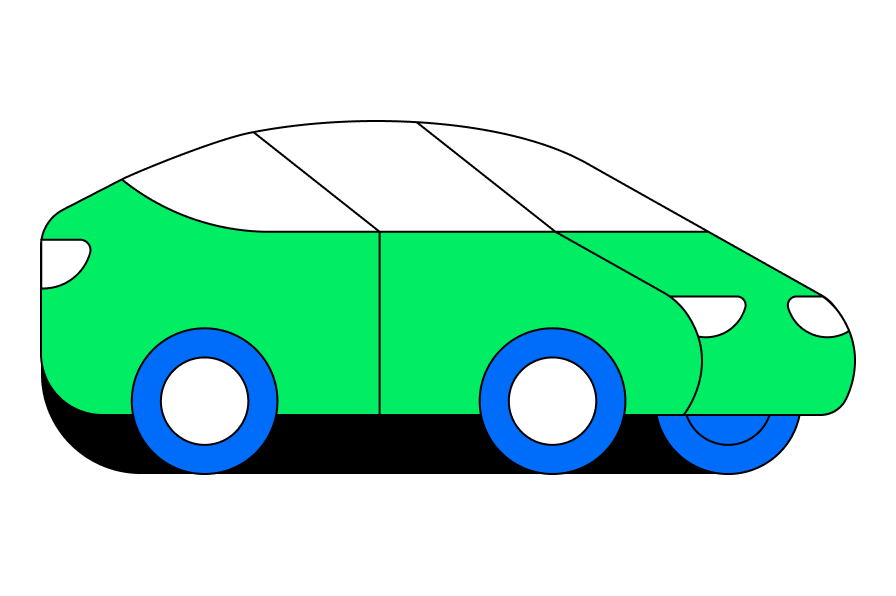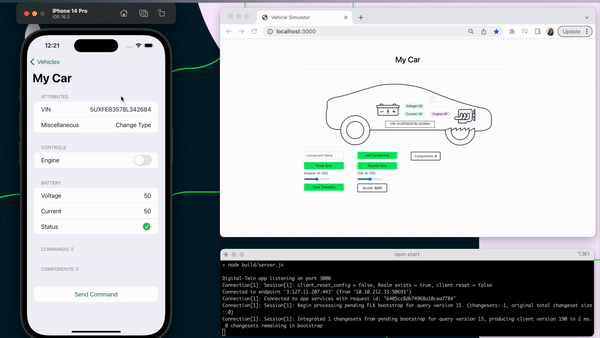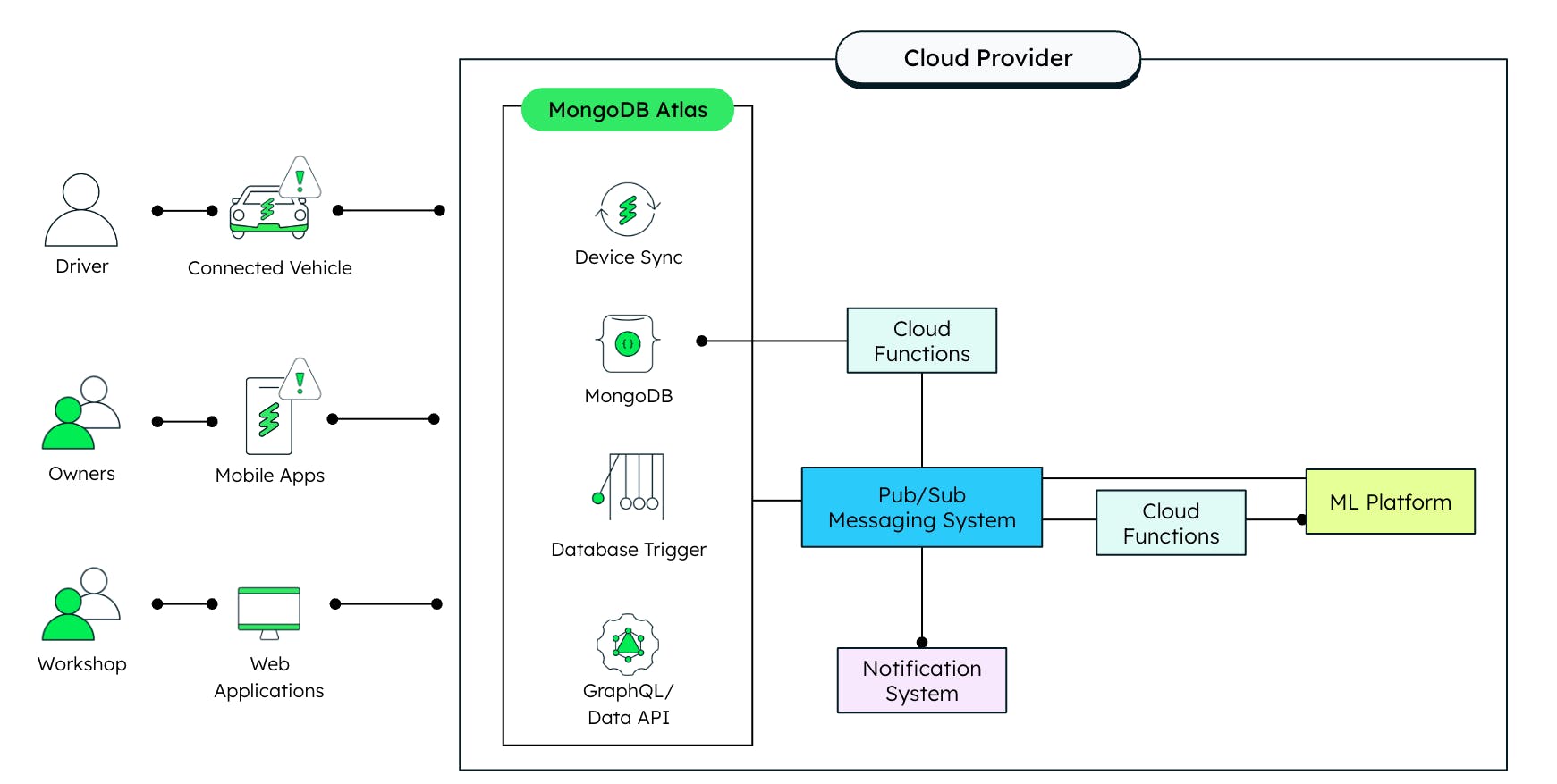- Use cases: IoT
- Industries: Manufacturing and Mobility
- Products and tools: Atlas, Atlas Device Sync, Atlas Triggers, Atlas Functions, Time Series
Connected vehicle solution

Solution Overview
By 2025, the estimated number of connected vehicles worldwide is expected to reach 400 million. Customers increasingly prioritize software functionality and integration into their digital lifestyle when choosing connected vehicles. This allows access to advanced information and control beyond traditional driving experiences. Features like autonomous driving will be enabled on demand via software applications, leading to new pay-per-use business models. Automakers recognize these trends but face challenges in achieving them efficiently. The efficiency afforded by MongoDB’s developer data platform and its evolving feature set make it a leading platform on AWS.
The demonstration uses MongoDB Atlas, Atlas Device SDK, and Atlas Device Sync to streamline integration work and accelerate the development of digital twin use cases and applications for connected vehicles.
By the end of this demo, you’ll have a vehicle simulator and mobile app built using MongoDB Atlas, Atlas Device SDK, and Atlas Device Sync, to showcase the concept of digital twins.

Other Applicable industries and use cases
Manufacturing: In manufacturing, digital twins can replicate production processes and equipment to optimize efficiency, identify bottlenecks, and reduce downtime. They also aid in monitoring equipment health and predicting maintenance needs.
Healthcare: Digital twins are used in the medical field to create personalized models of individual patients. These models help doctors better understand a patient's specific anatomy and plan complex surgeries or treatments accordingly.
Retail: Digital twins in the retail sector can replicate physical stores and analyze customer behavior to optimize store layouts, product placements, and inventory management.
Reference Architecture

This reference architecture is cloud agnostic. MongoDB can integrate with solutions from all the major cloud providers, such as AWS. Explore an example reference implementation like the one above for AWS.
Data Model Approach
There are different levels of data modeling in software-defined vehicles. These levels are usually referred to as the Knowledge Pyramid: Data, Information, Knowledge and Wisdom.
A popular data modeling approach for software-defined vehicles in the information layer is COVESA’s VSS (Vehicle Signal Specification), which is easily mapped to a MongoDB BSON Document. Each OEM and software company has their own implementation of VSS.
Regarding the Knowledge and Wisdom layers, these are typically handled by graph databases (such as SHACL). MongoDB Atlas can play an auxiliary role in the transformation of data from the Information layer (i.e. VSS) to the Knowledge layer. In the future, MongoDB may have a more primary role as a graph database with additional evolution of the product.
Building the Solution
A connected vehicle platform uses analytical data for safer, efficient driving experiences, enabled by bidirectional data exchange. MongoDB Atlas and AWS (including SageMaker) form the core. MongoDB ensures consistent data flow, while AWS extracts insights for driving recommendations. The integrated MongoDB and AWS components create a seamless end-to-end solution, detailed in the demo section.
1. Set up the MongoDB Atlas digital-twin backend
In order to make the demo work end-to-end, you will need to set up the backend. To get started, you’ll want to go through the setup steps listed in GitHub readme.
2. Set up the Typescript vehicle simulator
Here you will set up your vehicle simulator. You have three options for where you do so: locally, locally in a container, or on AWS VM. The most straightforward way is to run it locally, but you are free to choose the option best suited for your use case. Follow the steps provided in the GitHub documentation.
3. Set up the iOS Swift vehicle controller mobile application
Now you'll learn how to create the vehicle controller mobile application. Follow the steps provided in the GitHub documentation.
4. Set up the Amazon SageMaker integration
The AWS SageMaker integration allows you to analyze your data and then send that analyzed data back to MongoDB Atlas and consequently to the users of the devices. Follow the steps provided in the GitHub documentation.
Technologies and Products Used
MongoDB developer data platform:
Partner technologies:
Key Considerations
- Understand the use of Atlas Device SDK on edge devices (phones, vehicles, etc.) to build connected products at scale.
- How MongoDB integrates natively with external services (such as AWS Sagemaker) to provide even more powerful applications.
Authors
- Felix Reichenbach, MongoDB
- Humza Akhtar, MongoDB
- Arnaldo Vera, MongoDB
- Karolina Ruiz Rogelj, MongoDB
- Ainhoa Múgica, MongoDB
- Babu Srinivasan, MongoDB
- Mohan Yellapantula, AWS
Solve the Digital Twin Challenge
Explore how MongoDB and AWS provide building blocks for solving the digital twin challenge.
Digital Twin Data Middleware
Explore using MongoDB Atlas on AWS to remove the non-differentiating integration work between vehicles.
Digital Twin GitHub Repo
Solve the digital twin challenge with a telemetry feedback loop yourself with the sample data, functions, and code.
From Connected Equipment to Products
See how MongoDB reduces architectural complexity and helps you build applications near the shop floor.